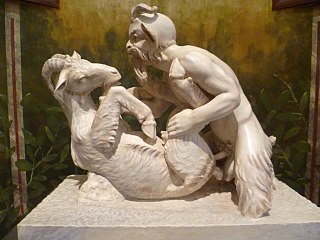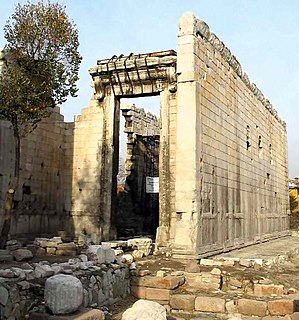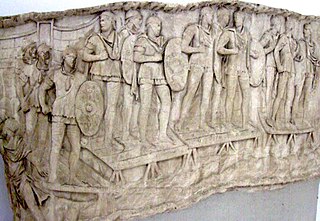Related Research Articles

Verulamium was a town in Roman Britain. It was sited southwest of the modern city of St Albans in Hertfordshire, England. A large portion of the Roman city remains unexcavated, being now park and agricultural land, though much has been built upon. The ancient Watling Street passed through the city. Much of the site and its environs is now classed as a scheduled monument.
Sextus Varius Marcellus was a Roman aristocrat and politician from the province of Syria.

Erotic art in Pompeii and Herculaneum has been both exhibited as art and censored as pornography. The Roman cities around the bay of Naples were destroyed by the eruption of Mount Vesuvius in 79 AD, thereby preserving their buildings and artefacts until extensive archaeological excavations began in the 18th century. These digs revealed the cities to be rich in erotic artefacts such as statues, frescoes, and household items decorated with sexual themes. The ubiquity of such imagery and items indicates that the treatment of sexuality in ancient Rome was more relaxed than current Western culture. However, much of what might strike modern viewers as erotic imagery, such as oversized phalluses, could arguably be fertility imagery. Depictions of the phallus, for example, could be used in gardens to encourage the production of fertile plants. This clash of cultures led to many erotic artefacts from Pompeii being locked away from the public for nearly 200 years.

The Praetorian Guard was a unit of the Imperial Roman army that served as personal bodyguards and intelligence agents for the Roman emperors. During the Roman Republic, the Praetorian Guard were an escort for high-rank political officials and were bodyguards for the senior officers of the Roman legions. In the year 27 BC, after Rome's transition from republic to empire, the first Emperor of Rome, Caesar Augustus, designated the Praetorians as his personal security escort. For three centuries, the guards of the Roman emperor were also known for their palace intrigues, by which influence upon imperial politics the Praetorians could overthrow an emperor, and then proclaim his successor as the new Caesar of Rome. In AD 312, Constantine the Great disbanded the cohortes praetoriae and destroyed their barracks at the Castra Praetoria.

Freeborn women in ancient Rome were citizens (cives), but could not vote or hold political office. Because of their limited public role, women are named less frequently than men by Roman historians. But while Roman women held no direct political power, those from wealthy or powerful families could and did exert influence through private negotiations. Exceptional women who left an undeniable mark on history include Lucretia and Claudia Quinta, whose stories took on mythic significance; fierce Republican-era women such as Cornelia, mother of the Gracchi, and Fulvia, who commanded an army and issued coins bearing her image; women of the Julio-Claudian dynasty, most prominently Livia and Agrippina the Younger, who contributed to the formation of Imperial mores; and the empress Helena, a driving force in promoting Christianity.
The equites constituted the second of the property-based classes of ancient Rome, ranking below the senatorial class. A member of the equestrian order was known as an eques.
The donativum was a gift of money by the Roman emperors to the soldiers of the Roman legions or to the Praetorian Guard. The English translation is donative.

The aureus was a gold coin of ancient Rome originally valued at 25 pure silver denarii. The aureus was regularly issued from the 1st century BC to the beginning of the 4th century AD, when it was replaced by the solidus. The aureus was about the same size as the denarius, but heavier due to the higher density of gold.

Res Gestae Divi Augusti is a monumental inscription composed by the first Roman emperor, Augustus, giving a first-person record of his life and accomplishments. The Res Gestae is especially significant because it gives an insight into the image Augustus offered to the Roman people. Various portions of the Res Gestae have been found in modern Turkey. The inscription itself is a monument to the establishment of the Julio-Claudian dynasty that was to follow Augustus.

The Edict on Maximum Prices was issued in 301 AD by Roman Emperor Diocletian.

In ancient geography, the Ligures Baebiani were a settlement of Ligurians in Samnium, Italy.

Tlos is an ancient ruined Lycian hilltop citadel near the resort town of Seydikemer in the Mugla Province of southern Turkey, some 4 kilometres northwest of Saklikent Gorge. Tlos is believed to be one of the most important religious Lycian sites and settlement on the site is said to have begun more than 4,000 years ago.

The Auxilia were introduced as non-citizen troops attached to the citizen legions by Augustus after his reorganisation of the Imperial Roman army from 30 BC. By the 2nd century, the Auxilia contained the same number of infantry as the legions and, in addition, provided almost all of the Roman army's cavalry and more specialised troops. The auxilia thus represented three-fifths of Rome's regular land forces at that time. Like their legionary counterparts, auxiliary recruits were mostly volunteers, not conscripts.

Veleia, an ancient town of Aemilia, Italy, situated about 15 km (9 mi) south of Placentia. It is mentioned by Pliny among the towns of the eighth region, though the Veleiates were ethnically Ligurians. Its inhabitants were, in the census of Vespasian, found to be remarkable for their longevity. Nothing further was known of it until 1747, when some ploughmen found the famous Tabula alimentaria, now in National Archaeological Museum of Parma. This, the largest inscribed bronze tablet of antiquity contains the list of estates in the territories of Veleia, Libarna, Placentia, Parma and Luca, in which Trajan had assigned before 102 CE 72,000 sesterces and then 1,044,000 sesterces on a mortgage bond to forty-six estates. The total value of which was reckoned at over 13,000,000 sesterces (~130,000), the interest on which at 5% was to serve for the support of 266 boys and 6 girls, the former receiving 16, the latter 12 sesterces a month.

Eumachia was the public priestess of Venus Pompeiana in Pompeii in the 1st century AD as well as the matron of the Fullers guild. She is known primarily from inscriptions on a large public building which she financed and dedicated to Pietas and Concordia Augusta.
The economics of the Roman army concerns the costs of maintaining the Imperial Roman army and the infrastructure to support it, as well as the economic development to which the presence of long-term military bases contributed. Supply contracts with the military generated trade with producers near the base, throughout the province, and across provincial borders.
The Imperial Roman army was the terrestrial armed forces deployed by the Roman Empire from about 30 BC to 476 AD, the final period in the long history of the Roman army. This period is sometimes split into the Principate and Dominate (285–476) periods.
The College of Aesculapius and Hygia was an association (collegium) founded in the mid-2nd century AD by a wealthy Roman woman named Salvia Marcellina, in honor of her dead husband and the procurator for whom he had worked. It is known from a lengthy inscription, dated March 11, 153 AD, that preserves the statute (lex) under which the college was constituted. The college was located on the Appian Way on the outskirts of Rome, between the first and second milestones near the oldest Temple of Mars at Rome. In addition to its commemorative purpose, the college served as a burial society and dining club for its members.

Konya Archaeological Museum is a state archaeological museum in Konya, Turkey. Established in 1901, it had been relocated twice before moving to its present location in 1962. One of the most prominent displays in the museum is of sarcophagi and other antiquities from the ancient city of Çatalhöyük. Other exhibits relate to the Neolithic, Bronze Age, Iron Age, Classical, Hellenistic, Roman and the Byzantine periods; artifacts consist of ceramic ware, stone and bronze wares, ornaments and inscriptions. A prominent display is of a marble sarcophagus of the 3rd century BC with elaborate sculpting events depicting the life of Hercules. In the outer open yard of the museum, there are a number of small sculptures, sarcophagi, column heads, and epigraphy.
Marcus Petronius Honoratus was a Roman eques who held a number of military and civilian positions during the reigns of the Emperors Hadrian and Antoninus Pius, which included praefectus annonae and praefectus or governor of Roman Egypt.
References
- ↑ Fant, Maureen B.; Lefkowitz, Mary R. (2005). Women's life in Greece and Rome : a source book in translation (3rd ed.). Baltimore, Md.: Johns Hopkins University Press. p. 159. ISBN 0-8018-8310-5.
- 1 2 Bond, Sarah Emily (2007). Ob Merita: The Epigraphic Rise and Fall of the Civic Patrona in Roman North Africa. Chapel Hill. pp. 28–29.